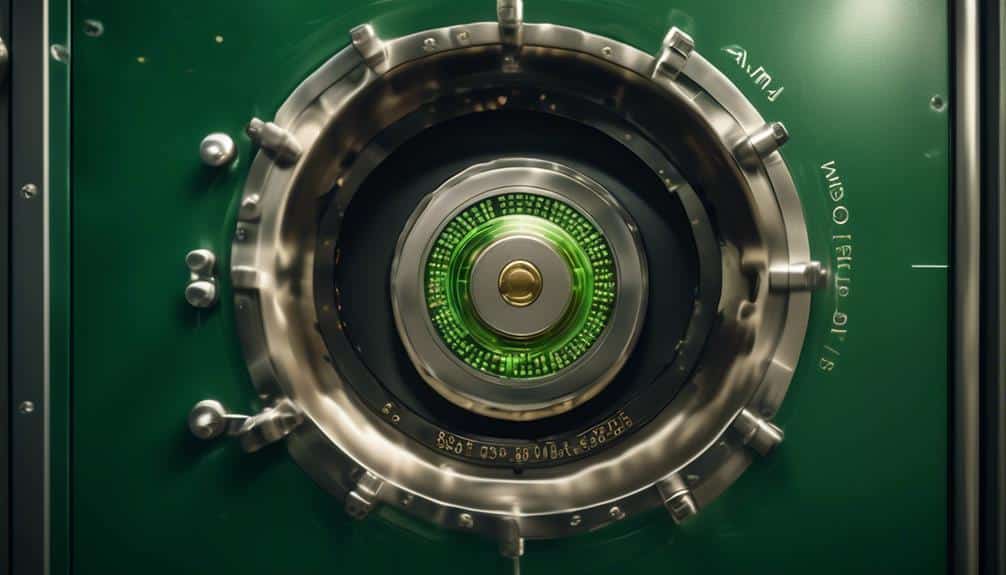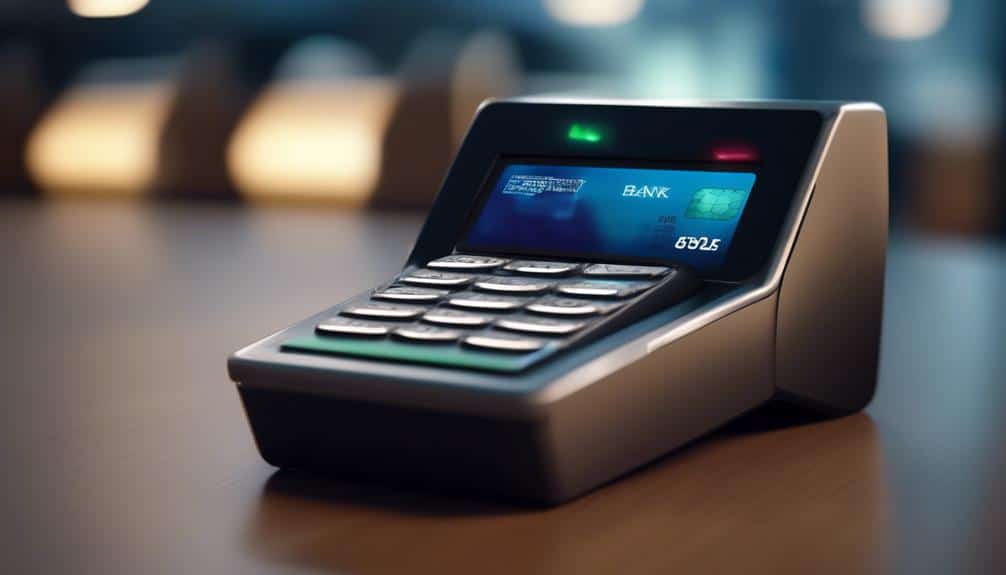They say that 'security is the key to success,' and when it comes to banks, this adage couldn't be truer. In a world where financial institutions are constantly at risk of breaches and theft, finding the best key systems becomes paramount.
So, what are the five best key systems for banks? Well, let's just say that these systems not only provide a sense of security but also offer efficiency and convenience.
Intrigued? Stay tuned as we explore the top five key systems that banks rely on to safeguard their assets and protect their customers.
Traditional Key and Lock Systems

Traditional key and lock systems have long been the backbone of security for banks, providing a physical barrier against unauthorized access to sensitive areas and safeguarding valuable assets. These systems offer several advantages.
Firstly, they're simple and intuitive to use, requiring minimal training for bank employees. Additionally, traditional key and lock systems are reliable and have a proven track record of durability, with keys lasting for years without the need for frequent replacement. Furthermore, these systems are cost-effective, as they don't require complex technology or ongoing maintenance.
However, there are also disadvantages to traditional key and lock systems. The main drawback is the risk of key duplication, which can lead to unauthorized access if a key falls into the wrong hands. Additionally, when an employee leaves the bank, changing locks and reissuing keys can be time-consuming and costly. Another limitation is the lack of flexibility in granting access. With traditional systems, each key is assigned to a specific individual, making it difficult to grant temporary access or revoke access remotely.
Comparing traditional key and lock systems with modern keyless entry systems, the latter offer several advantages. Keyless entry systems eliminate the risk of key duplication and provide enhanced security through features such as biometric authentication and audit trails. These systems also offer greater flexibility, allowing for temporary access and remote access management. However, keyless entry systems may be more expensive to implement and require regular software updates and maintenance.
Biometric Key Systems

Biometric key systems offer advanced security and convenience for banks, utilizing unique physiological characteristics for access control. These systems analyze and authenticate an individual's biometric data, such as fingerprints, iris patterns, voiceprints, or facial recognition, to grant or deny access to secure areas.
Here are four key advancements and future applications in biometric security:
- Enhanced security: Biometric key systems provide a higher level of security compared to traditional key and lock systems. As biometric data is unique to each individual, it's extremely difficult to forge or replicate. This reduces the risk of unauthorized access and fraudulent activities.
- Improved convenience: Biometric key systems eliminate the need for physical keys or passwords, making access control more convenient for bank employees and customers. Biometric data is always available and can't be forgotten or misplaced, streamlining the authentication process.
- Integration with other systems: Biometric key systems can be integrated with other security systems, such as surveillance cameras and alarm systems. This provides a comprehensive security solution, enhancing overall protection for banks.
- Future applications: Biometric key systems are continually evolving, and future advancements may include the use of vein patterns, heart rate variability, or DNA analysis for authentication. These technologies can further enhance security and ensure the uniqueness of biometric data.
Electronic Keycard Systems

Electronic keycard systems have become widely used in banks, providing a convenient and secure method for access control. These systems use electronic keycards, which are encoded with unique information that allows authorized individuals to gain entry to specific areas within a bank. The keycards contain a magnetic stripe or a smart chip that stores the necessary data for access.
One of the key benefits of electronic keycard systems is their enhanced security. Unlike traditional keys, electronic keycards can't be easily duplicated or lost. Additionally, these systems can be programmed to restrict access to certain areas based on the user's role or level of authorization. This ensures that only authorized personnel can access sensitive areas such as vaults or data centers, reducing the risk of unauthorized entry or theft.
Another advantage of electronic keycard systems is the convenience they offer. With keyless entry, employees no longer need to carry a bulky set of keys. Instead, they can simply swipe or tap their keycard on a reader to gain access. This eliminates the need for physical keys and reduces the chances of keys being misplaced or stolen.
Combination Key and Lock Systems

Combination key and lock systems provide a versatile and secure method of access control for banks. These systems offer several advantages and disadvantages that must be considered during implementation.
Advantages of combination key and lock systems:
- Increased security: Combination locks can be difficult to pick or tamper with, providing a higher level of security compared to traditional key systems.
- Flexibility: Combination locks allow for multiple users to access a single lock, eliminating the need for duplicate keys and simplifying the management of access control.
- Auditability: Combination locks can be programmed to record access attempts, providing a valuable audit trail for security purposes.
- Cost-effective: Combination locks are typically more affordable than electronic keycard systems, making them a cost-effective option for banks.
Despite their advantages, combination key and lock systems also come with some challenges during implementation in banks:
- Training: Bank staff may require training to properly use and manage combination locks, which can add to the overall implementation time and cost.
- User errors: Human error, such as forgetting the combination or misplacing it, can result in lockouts and additional maintenance efforts.
- Limited access control: Combination locks may not offer the same level of fine-grained access control as electronic keycard systems, limiting the ability to restrict access to specific areas or timeframes.
- Maintenance: Regular maintenance and testing of combination locks are necessary to ensure their continued functionality and security.
Restricted Key Systems

Restricted key systems offer a higher level of security and control by limiting access to specific individuals or groups within a bank. These systems are designed to provide strict access control and enhance the overall security measures of a bank. By using restricted key systems, banks can ensure that only authorized personnel have access to sensitive areas or assets, such as vaults, cash rooms, or data centers.
Access control is a critical aspect of bank security, and restricted key systems play a crucial role in achieving this. These systems use unique key profiles and patented keyways, making them difficult to duplicate or tamper with. Additionally, restricted key systems can be customized to allow different levels of access for different personnel. This ensures that only those with the necessary authorization can gain entry to specific areas, reducing the risk of unauthorized access or internal theft.
To further enhance security measures, restricted key systems often incorporate additional features such as key tracking, which allows banks to monitor the movement of keys and identify any anomalies or potential security breaches. Some systems also offer audit trail capabilities, enabling banks to track and review key usage history.
Frequently Asked Questions
What Are the Potential Security Risks Associated With Traditional Key and Lock Systems for Banks?
When it comes to traditional key and lock systems for banks, there are potential vulnerabilities that can have serious security implications. The outdated nature of these systems leaves them susceptible to manipulation and unauthorized access. This can put sensitive customer information and valuable assets at risk.
It's like leaving the front door of a bank wide open for anyone to walk in. That's why it's crucial for banks to explore more advanced and secure key systems to protect against these potential security risks.
How Do Biometric Key Systems Enhance the Security of Banking Institutions?
Biometric key systems greatly enhance the security of banking institutions. The advantages of biometric key systems include increased accuracy and reliability in verifying the identity of individuals accessing sensitive areas or information. These systems use unique physical or behavioral characteristics, such as fingerprints or iris scans, to grant access.
Are Electronic Keycard Systems Susceptible to Hacking or Unauthorized Access?
Electronic keycard systems can be susceptible to hacking or unauthorized access if proper security measures aren't in place. However, there are several measures that banks can take to prevent keycard hacking.
These include implementing strong encryption protocols, regularly updating keycard software, and conducting regular security audits. By taking these precautions, banks can enhance the security of their electronic keycard systems and minimize the risks associated with unauthorized access.
Can Combination Key and Lock Systems Be Easily Tampered With or Manipulated?
Combination key systems, oh, the epitome of security! With their intricate mechanisms and ability to thwart would-be intruders, what could possibly go wrong?
Well, let's delve into the vulnerabilities of traditional locks. While combination key systems may appear impervious, they can indeed be tampered with or manipulated. Whether it's through brute force, lock picking, or even decoding the combination, determined individuals can find a way in.
It's crucial for banks to consider these weaknesses and explore more advanced key systems to safeguard their valuable assets.
What Are the Limitations of Using Restricted Key Systems in Banks?
When considering the limitations of restricted key systems in banks, it's important to assess their impact on bank security. Restricted key systems may provide some level of protection by limiting unauthorized access. However, these systems aren't foolproof and can still be vulnerable to skilled individuals who may attempt to bypass or manipulate them.
Additionally, restricted key systems can be costly to implement and maintain, making them a potential financial burden for banks.


